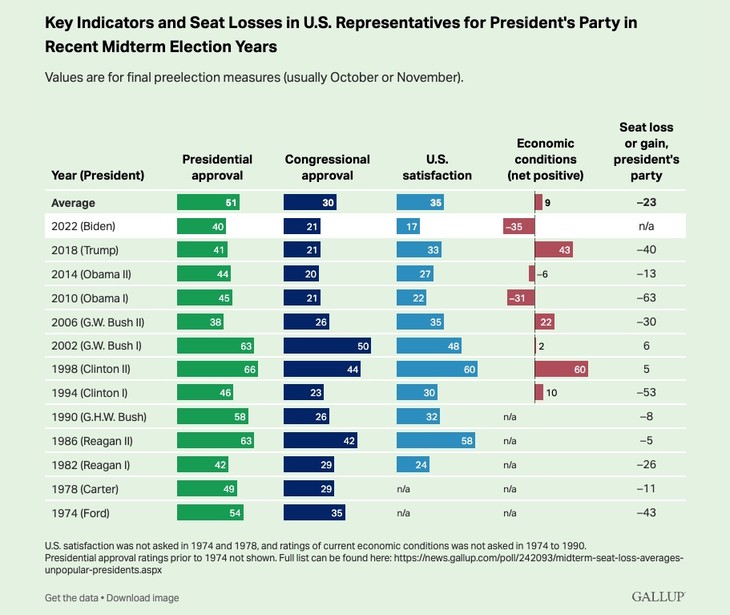Probably, we should emphasize. We’ve watched the GOP pull defeat from the jaws of victory before. Don’t get cocky, kid, and all that.
Still, the electoral planets have rarely if ever aligned to this extent for either party, or at least not in a very long time. A new report from Gallup shows voters more disaffected from the status quo than anytime in the 40-year history of its survey. Joe Biden’s popularity is second-lowest in that time span, and economic conditions the worst:

Heading into Election Day, 40% of Americans approve of the job Joe Biden is doing as president, 17% are satisfied with the way things are going in the U.S., 49% describe the health of the economy as poor (compared with 14% saying it is excellent or good), and 21% approve of the job the Democratically led Congress is doing.
Current ratings of the U.S. economy and national satisfaction are the lowest Gallup has measured at the time of a midterm election over the life of these polling trends, starting in 1994 and 1982, respectively. Congressional and presidential job approval are near their historical low marks.
The closest analog on that chart is the 2010 midterms, and we all know how those turned out. Republicans already hold about 25 of the seats that they gained in those midterms, so we won’t see a 63-seat flip — but the overall impact might result in a similar GOP majority in January. George W. Bush was slightly more unpopular than Biden is now in the 2006 midterms post-Katrina, and he lost both chambers of Congress in that election. And US satisfaction was twice as high then as it is now.
This is the clearest depiction of what I have been arguing for weeks, if not for months. The political environment in 2022 has no real solid model for just how toxic it will be to the governing party. Inflation and crime are both at sustained generational highs, and Joe Biden is simply awful at his job. Even using 2010 and/or 2014 as models won’t work, because the economy was nowhere near this bad and Obama nowhere near as unpopular as Biden, especially personally. Even Jimmy Carter was more likable than Biden.
In other words, we may not even have the right scale in place to predict what’s coming on Tuesday.
Even without that scale, though, these results portend a bad outcome for Democrats, Gallup concludes, and CNN’s Harry Enten agrees. Democrats’ only real hope in this cycle was that Republicans would find a way to screw up, but even that won’t change the direction of the coming red wave, Enten argues, and history gives us the likely parameters of the wave as well:
Importantly, this satisfaction with the direction of the country is highly correlated with midterm outcomes in the House. In the midterms when more Americans are dissatisfied than satisfied with the direction of the country, the party that held the White House has lost an average of 33 seats. That jumps to 46 seats in a president’s first midterm.
If we look at seat totals instead, the party holding the White House ends up with 186 seats on average when more Americans are dissatisfied than satisfied in a president’s first midterm. This would be an over 35 seat loss for Democrats in the 2022 midterms. Never has the President’s party ended up with more than 204 seats when more Americans were dissatisfied than satisfied.
Add to that the poor approval rating for this Congress:
The other first midterms where Congress’s approval rating was south of 25%: 1994, 2010 and 2018. All saw losses of at least 40 seats for the president’s party, which also controlled Congress at those times.
And finally, toss in the weight of the millstone around Democrats’ necks named Joseph Robinette Biden:
Perhaps, though, the most important factor to understand why Republicans have momentum is the President’s approval rating. I noted last week that the big question heading into the midterms was whether the Democrats could outrun President Joe Biden’s approval rating.
His approval in Gallup’s poll stood at 40%, which is the second worst for an incumbent president in a midterm since 1974. It is the worst for a first term incumbent. Biden’s disapproval rating was 56% in the survey.
No first-term president whose approval rating was below his disapproval rating in a midterm since 1974 has seen his party end up with more than 200 seats in the House.
With that in mind, one has to wonder why Biden went on television at all, either in August or last night. The best possible strategy would be for Biden to lay low with these trends in place.
Instead, he injected himself back into the midterms and nationalized them all over again — with an argument that has nothing to do with the top priorities of voters in this cycle. It didn’t even attempt to argue that the economy is better than voters think; Biden didn’t mention it at all. Nor did he attempt (as he has on occasion) to argue that this session of Congress had a track record of accomplishments, in order to soften that low approval rating or his own. Instead, he just doubled down on demonization and demagoguery, likely alienating voters even further from the repulsive two-year track record Biden has built in office.
Don’t get cocky indeed, and it still depends on people getting out to vote next Tuesday. But Biden’s demagogic close might make even the parameters Enten lays out a bit on the optimistic side for Democrats on the other side of Tuesday.







Join the conversation as a VIP Member